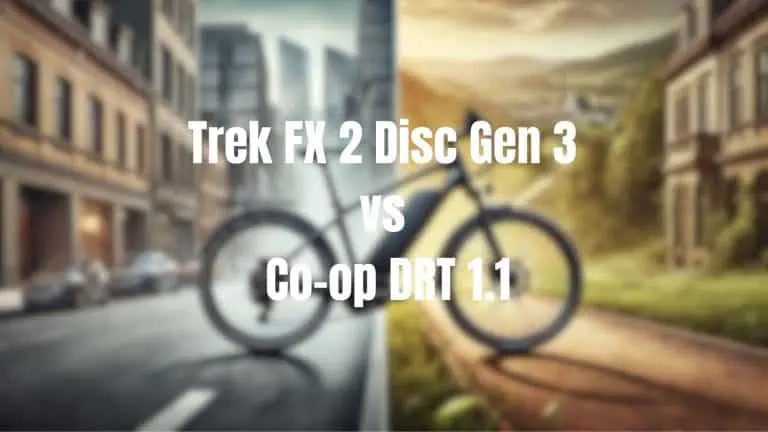RadCity 5 Plus vs Co-Op CTY e2.1: A Comprehensive Comparison
In the growing electric bike market, the RadCity 5 Plus and the Co-Op CTY e2.1 are two popular options for urban riders. Both bikes offer unique features tailored for city commuting, but they have some distinct differences. Let’s compare these two models to help you determine which might be the better fit for your needs.
Comparison Table
| Feature | RadCity 5 Plus | Co-Op CTY e2.1 |
|---|---|---|
| Price | $1,999.00 | $1,799.00 |
| Motor Type | Rear hub motor | Rear hub motor |
| Power | 750W | 250W |
| Brakes | Hydraulic disc | Mechanical disc |
| Pedal Assist vs. Throttle | Throttle | Pedal-assist |
| Weight | 65 lbs | 54 lbs. 8 oz. |
Price and Value
- RadCity 5 Plus: $1,999.00
- Co-Op CTY e2.1: $1,799.00
The Co-Op CTY e2.1 is $200 less expensive than the RadCity 5 Plus. While this price difference isn’t huge in the context of e-bikes, it could be a deciding factor for budget-conscious buyers. Both bikes are positioned in the mid-range price bracket for electric bikes.
Motor Type and Power
- RadCity 5 Plus: Rear hub motor, 750W
- Co-Op CTY e2.1: Rear hub motor, 250W
Both bikes use rear hub motors, but there’s a significant difference in power output. The RadCity 5 Plus boasts a 750W motor, which is three times more powerful than the 250W motor of the Co-Op CTY e2.1. This power difference could be noticeable, especially when climbing hills or accelerating from a stop.
Brakes
- RadCity 5 Plus: Hydraulic disc
- Co-Op CTY e2.1: Mechanical disc
The RadCity 5 Plus features hydraulic disc brakes, which generally offer better stopping power and require less maintenance than mechanical disc brakes. The Co-Op CTY e2.1 uses mechanical disc brakes, which are still effective but may require more frequent adjustment and might not provide quite the same level of modulation as hydraulic systems.
Pedal Assist vs. Throttle
- RadCity 5 Plus: Throttle
- Co-Op CTY e2.1: Pedal-assist
This is a significant difference between the two bikes. The RadCity 5 Plus has a throttle, allowing you to engage the motor without pedaling. This can be convenient in stop-and-go traffic or when you need a quick burst of speed.
The Co-Op CTY e2.1 uses a pedal-assist system, which provides power only when you’re pedaling. This creates a more natural riding experience and can help extend battery life.
Weight
- RadCity 5 Plus: 65 lbs
- Co-Op CTY e2.1: 54 lbs. 8 oz.
The Co-Op CTY e2.1 is about 10.5 pounds lighter than the RadCity 5 Plus. This weight difference could be noticeable when handling the bike off the road, such as when lifting it onto a bike rack or carrying it up stairs.
Additional Considerations
- Range: Due to its more powerful motor, the RadCity 5 Plus may have a shorter range than the Co-Op CTY e2.1, although this would depend on the specific battery capacities and usage patterns.
- Carrying Capacity: The RadCity 5 Plus, with its more powerful motor, may be better suited for carrying heavy loads or additional passengers.
- Brand and Support: Rad Power Bikes (maker of RadCity) is known for their direct-to-consumer model and has a strong reputation in the e-bike market. Co-Op is REI’s house brand, which comes with the backing of REI’s customer service and their excellent return policy.
Which is Better?
The choice between these two e-bikes depends on your specific needs and preferences:
- Power: If you need more power for hills or carrying capacity, the RadCity 5 Plus has a significant advantage with its 750W motor.
- Price: The Co-Op CTY e2.1 is slightly less expensive, which could be a deciding factor for some buyers.
- Weight: The Co-Op CTY e2.1 is notably lighter, which could be important if you need to carry the bike frequently.
- Ride Style: If you prefer a more traditional biking experience with pedal-assist only, the Co-Op CTY e2.1 might be preferable. If you want the option of using a throttle, the RadCity 5 Plus is the choice.
- Braking Performance: The RadCity 5 Plus has an edge with its hydraulic disc brakes.
In conclusion, the RadCity 5 Plus is better suited for riders who prioritize power, carrying capacity, and the flexibility of a throttle. It’s great for longer commutes, hilly terrain, or carrying groceries and gear.
The Co-Op CTY e2.1 might be preferable for those who want a lighter bike, prefer a pedal-assist-only system, and appreciate the backing of REI’s customer service. It could be ideal for flatter terrain and riders who prefer a more traditional cycling experience with electric assistance.
Consider your daily commute, local terrain, and riding preferences when making your decision. Both bikes offer quality rides but cater to slightly different needs in the urban e-bike market.






